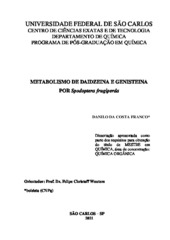Metabolismo de daidzeína e genisteína por Spodoptera frugiperda
Abstract
DAIDZEIN AND GENISTEIN METABOLISM BY Spodoptera frugiperda. As
sessile organisms, plants cannot escape the many herbivore attacks that occur
throughout their development, and rely on alternative strategies to reduce or
prevent these attacks, such as the production of toxic secondary metabolites.
However, many insects have adaptations that allow them to feed on chemically
well-defended plants. In this perspective, soybean (Glycine max (L) Merril), a
leguminous plant belonging to the Fabaceae family, produces several flavonoids
known to damage herbivorous insects. Despite this, soybean is attacked by a
variety of insects throughout its development, among which the fall armyworm,
Spodoptera frugiperda (J. E. Smith) stands out. Although it is considered a
secondary soybean pest, this species stands out for being able to attack soybeans
in their early stages of development, causing severe damage to the plant. Soybean
seedlings have relatively high concentrations of isoflavones, and the ability of S.
frugiperda to feed on this stage of the plant may be associated with its ability to
efficiently metabolize and detoxify this class of compounds. In this context, this
work aims to investigate how S. frugiperda metabolizes daidzein and genistein,
the two main soy isoflavones. Third instar caterpillars were used in feeding trials
with artificial diets added to the two isoflavones, which were isolated from
commercial soybean extracts. Feces samples excreted during the individual
bioassays with the isoflavones were collected and analyzed by LC-MS. In feces
from S. frugiperda fed a diet containing daidzein, only unmodified daidzein was
detected and in bioassays with genistein, the presence of a new metabolite derived
from genistein was observed. Which has been identified as a genistein
monoglucoside other than genistin (genistein 7-O-glucoside). These results
suggest that S. frugiperda extensively metabolizes the isoflavone genistein, as
opposed to daidzein. Finally, this work was the first to investigate the metabolism
of isoflavones by S. frugiperda, contributing to the understanding of this species
and its ability to metabolize bioactive compounds, whose findings can serve as a
basis for future studies that aim to understand the status of insect pest of this
species or of the genus Spodoptera.
Collections
The following license files are associated with this item:

